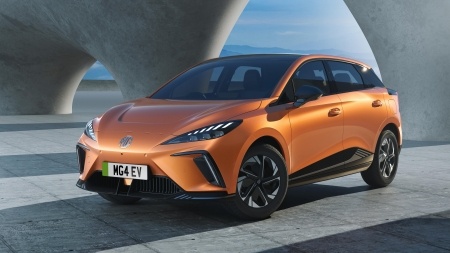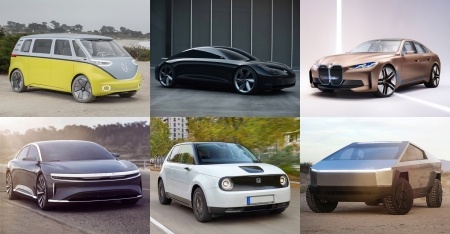
Busting electric vehicle jargon – from ACC to ZEV
Are you interested in electric cars but struggling to understand the terminology? Don't worry! Our simple guide helps you through the basics.
For every new technology there are new terms, and hybrid and electric vehicles (EVs) are no different. People talk about regenerative braking, battery cycles and quick charging – plus they throw around acronyms like ICE, BEV and ZEV. If you're considering buying or leasing an electric car you probably have lots of questions around how they work, which is best, and whether they're the right choice for you. But how can you decide if you don't understand what people are talking about?
In this guide we've picked out the most common and important terms around electric, hybrid and fuel-efficient vehicles. We'll explain what they mean, why they're important, and how things might change over the next couple of years.
EV
An electric vehicle (EV) is simply a fully-electric vehicle, without any conventional (petrol or diesel) power.
ACC
Adaptive Cruise Control (ACC) is already fitted to many cars, adaptive cruise control uses sensors to work out how fast the car in front is travelling and keeps you a safe distance behind it. It's not just for EVs: it helps all cars travel at a constant speed, avoiding 'concertinas' on the motorway where everyone brakes, then speeds up again.
Some high-end cars are now taking ACC to a new level, adding more sensors and pulling in very detailed road information from SatNav. This helps them save energy by predicting the best speed ahead of time. For example, by detecting a slower speed limit ahead and coasting to slow down, instead of using the brakes.
Autopilot
You've probably heard of Autopilot – the self-driving technology pioneered by Tesla. In fact, many cars can self-drive to some degree, from simple cruise control, to almost fully automatic driving in some limited circumstances, such as a motorway cruise.
AVAS
As electric cars are so quiet on the road, the Acoustic Vehicle Alerting System (AVAS) has recently been introduced as mandatory for all electric cars to emit an artificial noise while driving at slow speeds.
AWD
All Wheel Drive (AWD) vehicles have a drivetrain providing power to all its wheels, whether permanently or engaged on-demand as needed. Like ICEs, only some electric cars have AWD
Battery life
The rechargeable batteries used in electric and hybrid cars should last for many hundreds, or thousands, of charge cycles – i.e. charging up, being used, then charging up again. Car makers usually guarantee a minimum. Batteries won't fail at the end of their cycle life, but they won't store as much energy, so the car's electric range will be smaller.
BEV
Otherwise known as a pure electric or all-electric vehicle, a Battery Electric Vehicle (BEV) is a vehicle that runs solely on electricity from a battery.
BIK
Benefits in kind (BIK) are benefits which employees or directors receive from their employment but which are not included in their salary cheque or wages, such as company cars.
Tax is payable on a company car if it is available for private use by an employee, company director or their family or household. In nearly all cases, private use includes journeys between home and work. The tax charge is lower for cheaper cars, cars with lower CO2 emissions and cars that can run on alternative fuels.
Cars are also not taxable if:
- they are provided only for business, and
- they are not available for private use, and
- they are not actually used privately.
CCS
Combined Charging System (CCS) is a charging connector type that covers charging electric vehicles using the Combo 1 and Combo 2 connectors at up to 80 or 350 kilowatts. These two connectors are extensions of the Type 1 and Type 2 connectors, with two additional direct current (DC) contacts to allow high-power DC fast charging.
The Combined Charging System allows AC charging using the Type 1 and Type 2 connector depending on the geographical region. Since 2014 the European Union has required the provision of Type 2 or Combo 2 within the European electric vehicle network.
CHAdeMO
CHAdeMO is a charging cable connector type and an abbreviation of "CHArge de MOve", equivalent to "move using charge" or "move by charge", a reference to the fact that it's a fast charger. The name is derived from the Japanese phrase "O cha demo ikaga desuka", translating to English as "How about a cup of tea?", referring to the time it would take to charge a car. CHAdeMO can charge low-range (120km or 75mi) electric cars in less than half an hour.
Charging
There are a variety of standards for charging points, but they range from slow, through fast, to rapid. Rapid are the quickest, generally capable of charging cars to 80% in 20-40 minutes, depending on how big the battery is and how much charge it's holding to start with. Why 80%? Beyond that charging has to slow right down to avoid damaging the batteries.
Fast chargers take a few hours to recharge an EV. There are a few types, but a professional installer can fit the slowest, 7kW type in most homes or workplaces – find out more about charge stations here.
If all else fails you can generally get a slow charge anywhere – using a standard three-pin UK plug if necessary. It's a bit of a last resort, though: with a maximum 3kW available, it could take more than a day to recharge the biggest EV batteries.
EVHS
The Electric Vehicle Homecharge Scheme (EVHS) is a UK government incentive to install a charge point at homes that meet the criteria.
EVSE
Electric Vehicle Supply Equipment (EVSE) is the umbrella term to describe the equipment and its function to supply electricity to charge electric vehicles. Typically EVSE's are charging points, charging stations, cables and connectors. The primary function of EVSE is to keep you and your electric car safe while charging.
HEV
A Hybrid Electric Vehicle (HEV) combines a conventional engine – usually petrol – with batteries and an electric motor. But why? Hybrids usually use smaller and more efficient engines, relying on the electric motor for a bit of extra kick when needed. Cleverly, the motor is also used to recover energy and recharge the battery during braking or coasting (see regenerative braking, below). The end result is usually the same performance – or better – from less fuel.
There are two main types of hybrid. In a mild hybrid, the motor only helps the engine and recovers energy. In a full hybrid, the vehicle can run on its conventional engine, or the electric motor, or both working together.
ICE
We've all grown up with the Internal Combustion Engine (ICE) – usually just calling them a petrol or diesel engine. Technically an ICE is any engine that burns fuel to generate power, so you could include jets or even rockets – not that you'd expect to find one in a car!
ICEs are on the way out, but they're not dead yet. Until EVs hit the mainstream, car makers are still improving conventional engines.
kWh
A kilowatt hour (kWh) is simply a measure of how much energy a battery stores, with a higher figure giving a greater range. A hybrid car's batteries might store around 1kWh – enough for a couple of miles – while the range-topping Tesla Model S can store 100kWh, giving it a range of up to 335 miles.
Plug-in hybrid / plug-in hybrid electric vehicle (PHEV). A PHEV is essentially a hybrid vehicle with a bigger battery, giving it a longer all-electric range – perfect for city driving. As with a normal hybrid, the batteries are recharged by the electric motor during braking or coasting, and sometimes with help from the engine, but a full charge usually means plugging in.
Today, a PHEV offers a better range than the typical electric car, but to get the most from one you really either need to live near a charging point, or have your own.
MPGe
Miles Per Gallon Gasoline Equivalent (MPGe) is a measure the average distance in miles traveled per unit of energy consumed. It's used to compare ICE performance using gasoline with BEVs, HEVs and PHEVs. 1 MPGe ≈ 1 mi/(33.70 kW·h)
NEDC - New European Driving Cycle
NEDC is a series of tests to calculate the fuel consumption and CO2 emissions of a vehicle. Despite being called New European Driving Cycle (NEDC), it was developed in the 1980s and adopted in 1990 and last updated in 1997. The NEDC aimed to replicate how a car is typically being used in Europe but. Two fo the biggest issues was NEDC was based on theoretical driving behaviour and tests are all carried out in a laboratory. It's now been replaced by the WLTP.
PHEV
Plug-in Hybrid Electric Vehicle (PHEV) is a vehicle that has an ICE that runs on gasoline but also an electric motor that runs on electricity from a battery, hence 'hybrid'. The difference from other hybrids is electricity is generated into the battery by being plugged in, not through regenerative braking.
Range anxiety
Quite simply, range anxiety is worry about the battery running out of power before reaching a destination.
Regenerative braking
Moving objects store up kinetic energy, and to stop them you have to remove it again. When you hit the brakes in a normal car they create friction, converting the car's kinetic energy into heat. That's great for the cat that just ran in front of you, but terrible for fuel economy: getting going again means burning more fuel.
One of the best things about an electric motor is that you can also use it as a generator. Hard braking in an EV or hybrid still relies on friction, but during coasting or gentle braking the motor harvests the car's kinetic energy, slowing it down and recharging the batteries. It's not 100% efficient, but most of the energy is saved and available to get you going again.
ULEV
An Ultra Low Emissions Vehicle (ULEV), this is any electric or hybrid vehicle that emits less then 75g of carbon dioxide (CO2) per kilometre travelled, with a capability of travelling a minimum range of 10 miles with zero CO2 emissions.
ULEZ
An Ultra Low Emission Zone (ULEZ) is an area, usually within cities, that places restrictions and/or charges on vehicles entering the area to improve air quality, noise and traffic congestion.
V2G
Vehicle to grid (V2G) technology allows electric vehicle (EV) batteries to store energy and discharge it back to the electric grid. when it’s most needed – for instance at peak times of the day when usage across the UK is at its highest. This two-way exchange of energy provides a number of benefits.
VED
Vehicle Excise Duty (VED), otherwise known as road tax, is an annual tax that is levied as an excise duty and which must be paid for most types of vehicles which are to be used (or parked) on public roads in the United Kingdom.
WCS
The Workplace Charging Scheme (WCS), is a government funded initiative to encourage the adoption of electric vehicle charging points by providing financial support towards the up-front costs of buying and installing them.
Well-to-wheel
Energy doesn't appear by magic – fossil fuels have to be pumped out of the ground, refined and transported to the fuel pump, while EVs and PHEVs have to get their electricity from somewhere. Well-to-wheel describes the total environmental impact of different fuels from their point of origin, to the point at which they're used.
WLTP
Worldwide Harmonised Light Vehicle Testing Procedure is a new laboratory test used to measure fuel consumption and CO2 emissions from passenger cars, as well as their pollutant emissions. It replaces the outdated NEDC and considers:
- More realistic driving behaviour
- A greater range of driving situations (urban, suburban, main road, motorway)
- Longer test distances
- More realistic ambient temperatures, closer to the European average
- Higher average and maximum speeds
- Higher average and maximum drive power
- More dynamic and representative accelerations and decelerations
- Shorter stops
- Optional equipment: CO2 values and fuel consumption are provided for individual vehicles as built
- Stricter car set-up and measurement conditions
- Enables best and worst-case values on consumer information, reflecting the options available for similar car models
ZEV
Zero Emission Vehicles (ZEV) are anything created when a fuel is used. They can be as innocuous as water, but generally include at least the greenhouse gas carbon dioxide (CO2), along with gases like nitrous oxide (NO) and particulates.
Everything EV
Electric cars are the future: the new generation of travel. And as the UK leader in low-carbon energy, we’re here to get you on the road and ahead of the curve.
We offer a range of electric car options – from our stand-alone EV tariff all the way up to our complete option that includes our tariff, charger and an electric car lease. Enjoy 10,000 miles free for a year or a free charger when you go electric with us (1).
A new era of travel starts here. Are you ready?
See our options
You may also like to read
Cars of the future
What do you think the EVs of the future will look like?
Your top EV questions answered
Look no further than our list of your top questions.
EV buyer's guide
Choosing the right EV can be a challenge - our guide will help you find the car to suit your needs.
Related articles

Top 10 cheapest electric cars to buy in 2022

Electric Car Rental & Sharing
